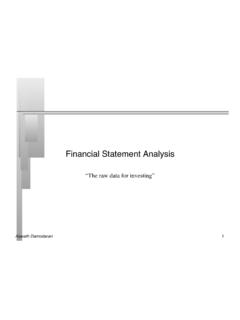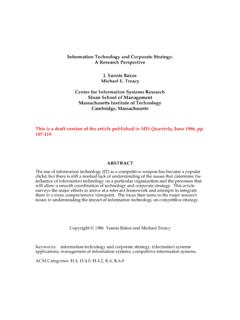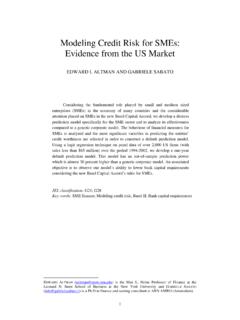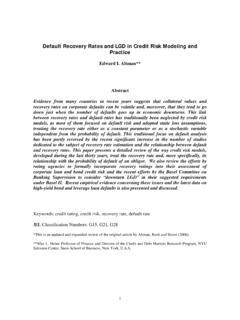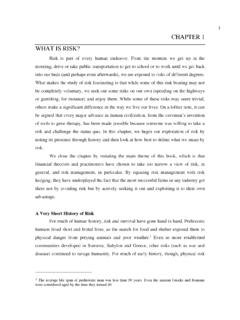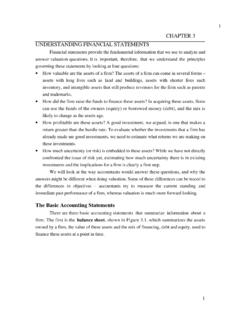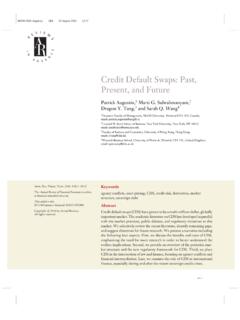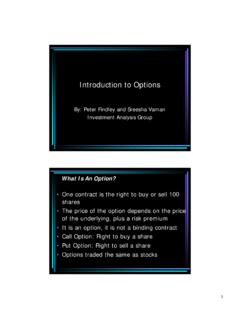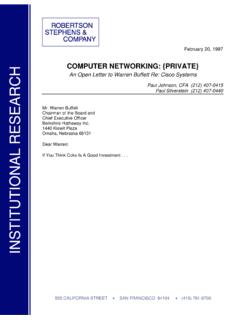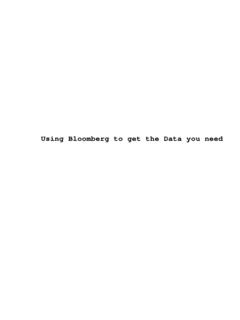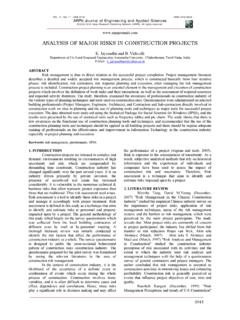Transcription of Investor Sentiment and the Cross-Section of Stock Returns
1 THE JOURNAL OF FINANCE VOL. LXI, NO. 4 AUGUST 2006 Investor Sentiment and the cross -Sectionof Stock ReturnsMALCOLM BAKER and JEFFREY WURGLER ABSTRACTWe study how Investor Sentiment affects the Cross-Section of Stock Returns . We pre-dict that a wave of Investor Sentiment has larger effects on securities whose valua-tions are highly subjective and difficult to arbitrage. Consistent with this prediction,we find that when beginning-of-period proxies for Sentiment are low, subsequent re-turns are relatively high for small stocks, young stocks, high volatility stocks, un-profitable stocks, non-dividend-paying stocks, extreme growth stocks, and distressedstocks. When Sentiment is high, on the other hand, these categories of Stock earnrelatively low subsequent FINANCE THEORY LEAVES NO ROLE FOR Investor Sentiment . Rather, thistheory argues that competition among rational investors, who diversify to opti-mize the statistical properties of their portfolios, will lead to an equilibrium inwhich prices equal the rationally discounted value of expected cash f lows, andin which the Cross-Section of expected Returns depends only on the cross -sectionof systematic if some investors are irrational, classical theory ar-gues, their demands are offset by arbitrageurs and thus have no significantimpact on this paper, we present evidence that Investor Sentiment may have signifi-cant effects on the Cross-Section of Stock prices.
2 We start with simple theoreticalpredictions. Because a mispricing is the result of an uninformed demand shockin the presence of a binding arbitrage constraint, we predict that a broad-based wave of Sentiment has cross - sectional effects (that is, does not simplyraise or lower all prices equally) when Sentiment -based demandsorarbitrage Baker is at the Harvard Business School and National Bureau of Economic Research; Wurgleris at the NYU Stern School of Business and the National Bureau of Economic Research. We thankan anonymous referee, Rob Stambaugh (the editor), Ned Elton, Wayne Ferson, Xavier Gabaix,Marty Gruber, Lisa Kramer, Owen Lamont, Martin Lettau, Anthony Lynch, Jay Shanken, MeirStatman, Sheridan Titman, and Jeremy Stein for helpful comments, as well as participants ofconferences or seminars at Baruch College, Boston College, the Chicago Quantitative Alliance,Emory University, the Federal Reserve Bank of New York, Harvard University, Indiana University,Michigan State University, NBER, the Norwegian School of Economics and Business, NorwegianSchool of Management, New York University, Stockholm School of Economics, Tulane University,the University of Amsterdam, the University of British Columbia, the University of Illinois, theUniversity of Kentucky, the University of Michigan, the University of Notre Dame, the Universityof Texas, and the University of Wisconsin.
3 We gratefully acknowledge financial support from theQ Group and the Division of Research of the Harvard Business Gomes, Kogan, and Zhang (2003) for a recent model in this Journal of Financeconstraints vary across stocks. In practice, these two distinct channels lead toquite similar predictions because stocks that are likely to be most sensitive tospeculative demand, those with highly subjective valuations, also tend to bethe riskiest and costliest to arbitrage. Concretely, then, theory suggests twodistinct channels through which the shares of certain firms newer, smaller,more volatile, unprofitable, non-dividend paying, distressed or with extremegrowth potential, and firms with analogous characteristics are likely to bemore affected by shifts in Investor investigate this prediction empirically, and to get a more tangible sense ofthe intrinsically elusive concept of Investor Sentiment , we start with a summaryof the rises and falls in market Sentiment from 1961 through the Internetbubble.
4 This summary is based on anecdotal accounts and thus by its naturecan only be a suggestive, ex post characterization of f luctuations in , its basic message appears broadly consistent with our theoreticalpredictions and suggests that more rigorous tests are main empirical approach is as follows. Because cross - sectional patternsof Sentiment -driven mispricing would be difficult to identify directly, we ex-amine whether cross - sectional predictability patterns in Stock Returns dependupon proxies for beginning-of-period Sentiment . For example, low future returnson young firms relative to old firms, conditional on high values for proxies forbeginning-of-period Sentiment , would be consistent with the ex ante relativeovervaluation of young firms. As usual, we are mindful of the joint hypothesisproblem that any predictability patterns we find actually ref lect compensationfor systematic first step is to gather proxies for Investor Sentiment that we can use astime-series conditioning variables.
5 Since there are no perfect and/or uncontro-versial proxies for Investor Sentiment , our approach is necessarily , we consider a number of proxies suggested in recent work andform a composite Sentiment index based on their first principal component. Toreduce the likelihood that these proxies are connected to systematic risk, wealso form an index based on Sentiment proxies that have been orthogonalized toseveral macroeconomic conditions. The Sentiment indexes visibly line up withhistorical accounts of bubbles and then test how the Cross-Section of subsequent Stock Returns varies withbeginning-of-period Sentiment . Using monthly Stock Returns between 1963 and2001, we start by forming equal-weighted decile portfolios based on several firmcharacteristics. (Our theory predicts, and the empirical results confirm, thatlarge firms will be less affected by Sentiment , and hence value weighting willtend to obscure the relevant patterns.)
6 We then look for patterns in the averagereturns across deciles conditional upon the beginning-of-period level of senti-ment. We find that when Sentiment is low (below sample average), small stocksearn particularly high subsequent Returns , but when Sentiment is high (aboveaverage), there is no size effect at all. Conditional patterns are even sharperwhen we sort on other firm characteristics. When Sentiment is low, subsequentreturns are higher on very young (newly listed) stocks than older stocks, high-return volatility than low-return volatility stocks, unprofitable stocks thanprofitable ones, and nonpayers than dividend payers. When Sentiment is high, Investor Sentiment and the Cross-Section of Stock Returns1647these patterns completely reverse. In other words, several characteristics thatdo not have any unconditional predictive power actually display sign-f lippingpredictive ability, in the hypothesized directions, once one conditions on senti-ment.
7 These are our most striking findings. Although earlier data are not asrich, some of these patterns are also apparent in a sample that covers 1935through sorts also suggest that Sentiment affects extreme growth and distressedfirms in similar ways. Note that when stocks are sorted into deciles by salesgrowth, book-to-market, or external financing activity, growth and distressfirms tend to lie at opposing extremes, with more stable firms in the middledeciles. We find that when Sentiment is low, the subsequent Returns on stocks atboth extremes are especially high relative to their unconditional average, whilestocks in the middle deciles are less affected by Sentiment . (The result is notstatistically significant for book-to-market, however.) This U-shaped patternin the conditional difference is also broadly consistent with theoretical pre-dictions: both extreme growth and distressed firms have relatively subjectivevaluations and are relatively hard to arbitrage, and so they should be expectedto be most affected by Sentiment .
8 Again, note that this intriguing conditionalpattern would be averaged away in an unconditional then consider a regression approach, which allows us to control for co-movement in size and book-to-market-sorted stocks using the Fama-French(1993) factors. We use the Sentiment indexes to forecast the Returns of varioushigh-minus-low portfolios (in terms of sensitivity to Sentiment ). Not surpris-ingly, given that our decile portfolios are equal-weighted and several of thecharacteristics we examine are correlated with size, the inclusion ofSMBasa control tends to reduce the magnitude of the predictability , although somepredictive power generally then turn to the classical alternative explanation, namely, that they sim-ply ref lect a complex pattern of compensation for systematic risk. This expla-nation would account for the predictability evidence by either time variationin rational, market-wide risk premia or time variation in the cross -sectionalpattern of risk, that is, beta loadings.
9 Further tests cast doubt on these hy-potheses. We test the second possibility directly and find no link between thepatterns in predictability and patterns in betas with market Returns or con-sumption growth. If risk is not changing over time, then the first possibilityrequires not just time variation in risk premia, but also changes in sign. Putsimply, it would require that in half of our sample period (when Sentiment isrelatively low), older, less volatile, profitable, and/or dividend-paying firms ac-tually require a risk premium over very young, highly volatile, unprofitable,and/or nonpayers. This is counterintuitive. Other aspects of the results alsosuggest that systematic risk is not a complete results challenge the classical view of the Cross-Section of Stock pricesand, in doing so, build on several recent themes. First, the results complementearlier work that shows Sentiment helps to explain the time series of Returns (Kothari and Shanken (1997), Neal and Wheatley (1998), Shiller (1981, 2000),Baker and Wurgler (2000)).
10 Campbell and Cochrane (2000), Wachter (2000),Lettau and Ludvigson (2001), and Menzly, Santos, and Veronesi (2004) examine1648 The Journal of Financethe effects of conditional systematic risks; here we condition on Investor sen-timent. Daniel and Titman (1997) test a characteristics-based model for thecross-section of expected Returns ; we extend their specification into acondi-tionalcharacteristics-based model. Shleifer (2000) surveys early work on sen-timent and limited arbitrage, two key ingredients here. Barberis and Shleifer(2003), Barberis, Shleifer, and Wurgler (2005), and Peng and Xiong (2004) dis-cuss category-level trading, and Fama and French (1993) document comove-ment of stocks of similar sizes and book-to-market ratios; uninformed demandshocks for categories of stocks with similar characteristics are central to ourresults. Finally, we extend and unify known relationships among Sentiment ,IPOs, and small Stock Returns (Lee, Shleifer, and Thaler (1991), Swaminathan(1996), Neal and Wheatley (1998)).
